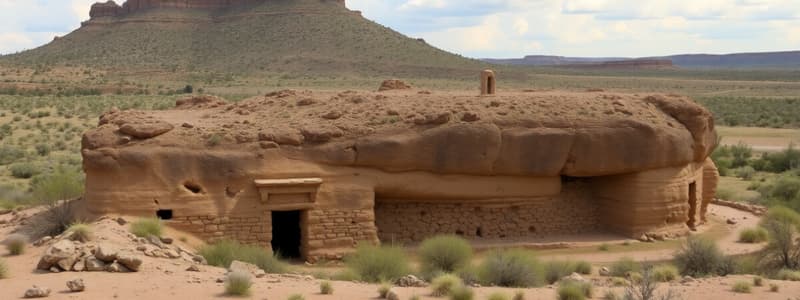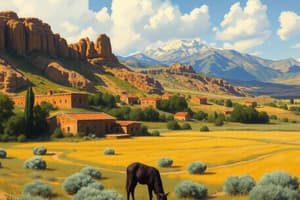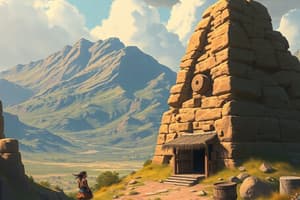Podcast
Questions and Answers
What percentage of the population decline in Pueblo communities occurred during the 17th century?
What percentage of the population decline in Pueblo communities occurred during the 17th century?
- 70%
- 80% (correct)
- 50%
- 60%
What ecological practice did Pueblo people engage in prior to their population decline?
What ecological practice did Pueblo people engage in prior to their population decline?
- Expanding agricultural lands
- Active wildlife management
- Controlled forest growth
- Preventing large-scale fires (correct)
What shift occurred in Pueblo communities after the collapse of Chaco?
What shift occurred in Pueblo communities after the collapse of Chaco?
- Communities adopted more efficient practices (correct)
- Focus on individual land ownership increased
- Power structures became less equitable
- Hierarchy became more pronounced
What environmental adaptation technique allowed Pueblo villages to manage stress?
What environmental adaptation technique allowed Pueblo villages to manage stress?
What was a significant impact of Spanish missions on Pueblo communities?
What was a significant impact of Spanish missions on Pueblo communities?
What was the frequency of fires in Pueblo areas before the population decline?
What was the frequency of fires in Pueblo areas before the population decline?
What is a modern implication of collaborating with Pueblo communities?
What is a modern implication of collaborating with Pueblo communities?
What lesson can be learned from the balance between power and efficiency in Pueblo communities?
What lesson can be learned from the balance between power and efficiency in Pueblo communities?
Flashcards
Anasazi Population Crash
Anasazi Population Crash
An 80% decline in the Anasazi population during the 17th century, largely attributed to epidemic diseases like smallpox and typhus caused by contact with Spanish missions.
Pueblo Forest Management
Pueblo Forest Management
Prior to the collapse, Pueblo people actively managed their forests, preventing large-scale fires by controlling underbrush.
TEK - Traditional Ecological Knowledge
TEK - Traditional Ecological Knowledge
The traditional ecological knowledge and practices of Indigenous peoples, which can provide valuable insights for modern environmental challenges.
Chaco Collapse
Chaco Collapse
Signup and view all the flashcards
Efficiency vs Growth
Efficiency vs Growth
Signup and view all the flashcards
Migration to Riverine Villages
Migration to Riverine Villages
Signup and view all the flashcards
More Egalitarian Social Structures
More Egalitarian Social Structures
Signup and view all the flashcards
Spanish Missions Impact
Spanish Missions Impact
Signup and view all the flashcards
Study Notes
Anasazi America Study Summary
-
Population Decline: An 80% decline in the Anasazi population occurred during the 17th century, attributed to epidemic diseases (smallpox, typhus) from sustained contact with Spanish missions.
-
Ecological Management: Prior to the population decline, Pueblo people actively managed forests, preventing large-scale fires by controlling underbrush and gathering firewood. This demonstrates their impact on the ecosystem.
-
Fire Frequency Increase: After the population decline, fire frequency increased from every 17 years to every 11 years, highlighting how human management affects ecosystems.
-
Modern Implications: Today's frequent wildfires reflect a lack of sustainable land management, suggesting the need for a renewed approach to environmental stewardship.
-
Traditional Ecological Knowledge (TEK): Collaboration with Jemez Pueblo seeks to revitalize TEK to address modern environmental challenges, showcasing the potential return to traditional practices.
-
Core Themes: The study focuses on the contrast between power and sustainability, exemplified by the Anasazi's management practices.
Chaco Culture Collapse
-
Centralized Leadership: Chaco's leadership controlled trade and rituals, but heavily relied on external resources and was vulnerable to external pressures.
-
Collapse Triggers: The collapse was triggered by an imbalance between growth demands and environmental stressors, worsened by drought conditions.
-
Post-Collapse Adaptation: Post-collapse Pueblo communities shifted to more equitable and sustainable practices, diversifying economic activities while maintaining cultural cohesion through rituals.
-
Efficiency vs Growth: The takeaway emphasizes the importance of prioritizing efficiency over growth for long-term resilience.
Transition to Pueblo Communities
- Migration Patterns: The movement from upland Chaco settlements to riverine villages, such as the Rio Grande, focused on cooperative farming, water management, and the preservation of rituals.
More Egalitarian Social Structures
-
Governance Shift: Shared labor and kinship-based governance replaced hierarchical structures. Ritual spaces, like kivas, strengthened community identity and spiritual continuity.
-
Environmental Adaptation: Irrigation and multi-zonal farming techniques enabled communities to adapt and endure environmental stress.
Impact of Spanish Missions
-
Forced Population Density: Spanish missions forced Pueblo communities into densely populated settlements, thereby increasing the risk of epidemic spreading.
-
Population Consolidation: This consolidation resulted in the abandonment of peripheral villages, impacting the overall population distribution.
Long-Term Resilience Strategies
-
Dual Religious Adaptation: While outwardly adopting Catholicism, Pueblo communities covertly maintained their traditional rituals. Cultural preservation, particularly of the language, was a key element of their survival.
-
Community Continuity: Survival showcases resilience, adaptation, and the importance of sustainable living, particularly in the face of external pressures.
Return to Jemez
-
Human Impact on Ecosystems: Pre-contact forest management minimized wildfires by reducing fuel. Population decline led to an increase in fire frequency demonstrating the critical role of human management.
-
Modern Fire Management: Traditional ecological knowledge (TEK) is relevant to reducing wildfire risks, reflecting the importance of cultural understanding in modern environmental management.
-
Collaboration with Pueblo Communities: Partnerships between archaeologists and Indigenous communities are essential in reviving and applying traditional knowledge to address modern challenges.
Takeaways and Final Thoughts
-
Growth vs Sustainability: Chaco and Pueblo communities offer contrasting models of growth and sustainability, highlighting risks of prioritizing growth over sustainable practices emphasizing long-term environmental resilience and cultural continuity.
-
Lessons from the Past: Lessons from the past offer a toolkit to generate future sustainable, resilient communities.
Studying That Suits You
Use AI to generate personalized quizzes and flashcards to suit your learning preferences.



